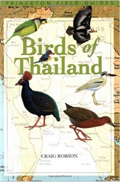| Doi
Phu Kha National Park |
| Introduction |
Doi
Phu Kha National Park covers 1680 square kilometres of forested
mountains in Nan province, close to the border with Laos.
These limestone mountains reach a height of 1980 metres (6140
feet) above sea level with three types of forest present;
dry dipterocarp, mixed deciduous and hill evergreen. The high
peaks and ridges continue to reveal new birds in this seldom
visited park, which was only designated in June 2000. Doi
Phu Kha is a lovely place to rest and explore side trails
off of the long road through the park, hopefully resulting
in sightings of some exciting species.
The best
time to visit for birdwatchers is between November and February
when there is little rain and large numbers of migrant birds
are present. As one proceeds up the road accessing the park,
a fabulous view across mountain ridges reveals itself. Within
the park spectacular views remain a feature from a number
of points, particularly the viewpoints along the road 5 and
9 km from the headquarters. |
|
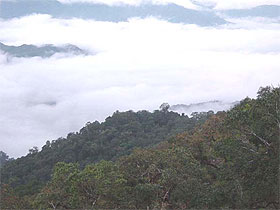
Forested
Ridges - Doi Phu Kha
(Photo from dnp.go.th) |
|
|
About
Google adverts |
| Birding
Highlights |
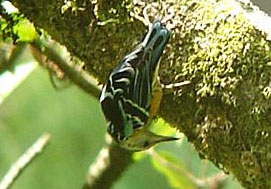
Beautiful Nuthatch
(Photo by Dion Hobcroft/VENT) |
|
Doi
Phu Kha has revealed a number of exciting high altitude species
that were previously though to only exist in Thailand at a
few sites in Chiang Mai province. Crested Finchbill, Red-faced
Liocichla, Black-throated Tit and Green Cochoa have all been
seen on this mountain. This location is also one of just two
places in Thailand that Beautiful Nuthatch has been observed,
and although this species has not been reported for a few
years, it is believed to be a resident.
The much
sought-after Jerdon's Bushchat also occurs here alongside
swampy ponds and the majestic Black Eagle can be found quartering
the hillsides. In fact, Doi Phu Kha's geographical location,
size and the fact that it remains relatively unexplored, mean
that there are probably a large number of species to be added
to the checklist. |
|
| Click
for a checklist of the birds of Doi
Phu Kha |

|
|
Bird
Tours : Check the suggested itineraries for
ideas on creating a tailor-made birdwatching trip to Thailand:
Thailand
bird tours. |
|
|
| Travel
Information |
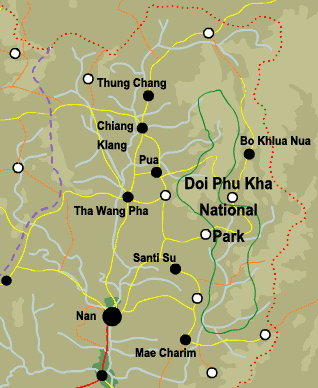
|
|
Although
Doi Phu Kha is quite isolated and seldom visited by foreign
birdwatchers, it is actually a fairly easy place to get to.
Most people
will probably be coming from either Bangkok or Chiang Mai.
Whichever of these you are coming from, or from any other
provincial town, the first step of the journey is to get to
Nan. Buses from Mor Chit in Bangkok or the main bus station
in Chiang Mai will terminate in Nan. All nearby provincial
capitals also have regular bus services here too.
From Nan
buses run to the small town of Pua, about 60km north of Nan;
this road is well-made and quite fast, meaning that this journey
takes only about an hour.
For those
using public transport the good news is that songthaews run
up the mountain from Pua all the way to park headquarters.
For those driving, the turning is in Pua, on the right when
coming from Nan: Doi Phu Kha NP is clearly signposted. This
road becomes quite steep and narrow with steep drops next
to the road at a few points. The road is also quite windy
and all of this makes it important to drive carefully. However,
a four-wheel drive is not necessary so long as your car is
in good condition.
The main
birding points are spread out over quite a long distance and
although it is possible to get a songthaew or hitch a ride,
it would be far preferable to have the benefit of ones own
vehicle at Doi Phu Kha. |
|
|
About
Google adverts |
| Finding
Birds |
Forest
anywhere along the road through the national park will reveal plenty
of birds, but there are a few places which are particularly good
for birdwatching.
Note:
The map below is compiled mainly from memory, due to the lack of
decent maps to use as reference. The road is far more windy than
illustrated but the main points are fairly accurately placed, however,
as far as I remember there are further side turnings and possible
trails along the road. If anyone is able to add to this map please
e-mail me: nickupton@thaibirding.com |
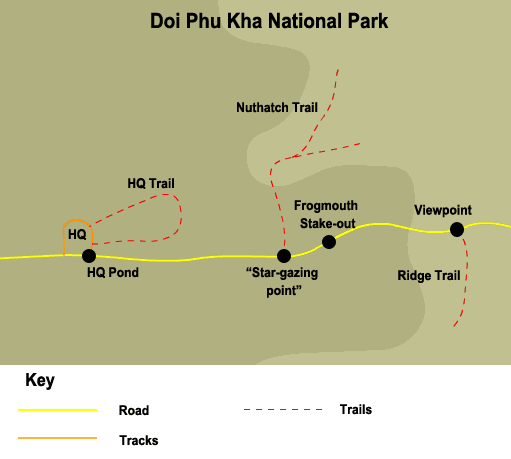
|
Pond
at HQ Entrance:
A small, swampy/reedy drainage pond at the entrance to HQ
is worth spending a few moments at. As well as some forest
species coming to drink here, on my visit in 2003 I flushed
a male Jerdon's Bushchat from the reeds, which then sat on
an overhead wire, before returning to the dense undergrowth.
I also saw a Striated Heron here (unusually high altitude)
and at this height I guess Black-tailed Crake would have to
be a possibility. Who knows what else could show up here?
Trail
from HQ:
This 4
kilometre trail follows a loop starting from the campsite
and finishing near the staff accommodation, or the other way
around depending on where you begin. The trail is easy to
follow and goes through some really nice forest patches as
well as areas of secondary growth and clearings. It doesn't
go high enough for many of the high altitude specialities,
but it does still provide plenty of good birdwatching opportunities.
Whiskered Yuhina was particularly numerous near the staff
accommodation end on my visit and Chestnut-capped Babbler
was present in grassy clearings. Other forest birds here include
Crested Goshawk, White-browed Scimitar Babbler, Blue-and-white
Flycatcher and Speckled Piculet. |
|
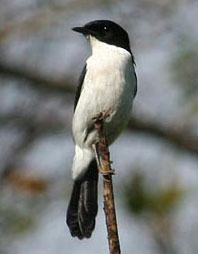
Jerdon's Bushchat
(Photo by Peter
Ericsson) |
|
| Headquarters:
HQ is spread out
over quite a large area of open forest and patches of low secondary
growth. Plenty of species can be found around here including Grey
Treepie, Blue Rock Thrush, Grey-backed Shrike and numerous species
of bulbul. |
Star-gazing
point:
This area is
also used as a campsite and has a few foodstalls selling simple
food and snacks; it is 5 kilometres from HQ - 31 km from Pua. Birding
can be done along the road and from the viewpoint as well as along
a few small tracks that head steeply downhill. In this area many
great species can be seen such as Crested Finchbill, Blue-winged
Minla, Silver-eared Mesia, Little Pied Flycatcher whilst Black Eagle
can be seen quartering the hillside.
Walking north
along the road leads to the "Chompoo Tree", but before
reaching this a number of gullies on both sides of the road should
be investigated for species such as Ferruginous Flycatcher, White-throated
Fantail, White-gorgetted Flycatcher, Lesser Shortwing and Streaked
Wren Babbler. |
| Frogmouth
Stake-out:
Six kilometres
after HQ - 32 km from Pua, a Hodgson's Frogmouth has been heard calling
on the right hand side of the road as one goes uphill. Apparently
it has not responded to tape and the vegetation is very thick and
the slope is very steep, so the chances of finding it may be small. |
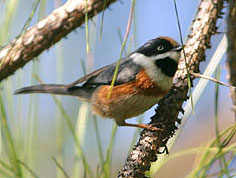
Black-throated Tit
(Photo by Suppalak
Klabdee) |
|
Nuthatch
Trail:
This trail
begins behind a small temple-like structure which is on the
left as one heads uphill, opposite the star-gazing point.
The trail is very steep for about 1 hour, whereupon a ridge
is reached. After walking along the ridge for about 50 metres
the trail forks; take the left hand fork which becomes a bit
overgrown but after about 100 metres one enters some good
forest. In this area beautiful nuthatch has been seen on a
number of occasions and has been confirmed to breed. Other
excellent species seen up at this altitude are Black-throated
Tit, Red-faced Liocichla, Striated Bulbul and Grey-cheeked
Warbler which seems to be a regular here.
Ridge
Trail:
This trail starts at a small car park and heads off to the
left along some high ridges. This is the highest point of
the road and although I haven't followed this trail the quality
of the habitat and altitude should mean that it is worthwhile
exploring. |
|
| Facilities |
|
About
Google adverts |
| There
are quite a number of accommodation options provided by the national
park, ranging from totally dire to rather nice indeed. |
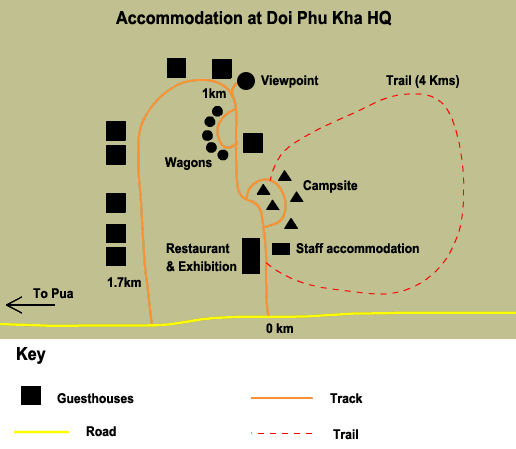 |
Visitors
need to report to the staff upon entering, and this is done at the
small restaurant area; here one can book the accommodation required.
The thatched
wagons are the cheapest option (other than camping) but quite frankly
they look dreadful, tiny, falling apart and damp; I should avoid
these completely.
The campsite
is fairly pleasant and toilets are nearby.
All the guesthouses
are quite decent, but I was most surprised to find that the ones
in a line on the west of the above map are really nice. They are
quite big, with a small kitchen area and a long open sleeping area
with large windows and a fantastic view. These guesthouses also
an outside veranda to sit and enjoy the view or view birds: all
guesthouses have bathrooms. Prices start from 800 baht per night
and the guesthouses can sleep loads of people. |
| The
small restaurant sells good food, but opening hours were somewhat
restricted on my visit and due to the remote location many things
on the menu had to be ordered a couple of days in advance in order
that they could be obtained in time. |
| There
are also a few small places to eat and buy snacks at the star-watching
place and this location doubles as a second campsite; toilets are
present. For those who want to hike up to the ridges, this is probably
a good option, so that one can get up early and begin the hike. |
It
is quite likely that visitors will need to stay outside the park
for at least one night, and whilst there are a number of adequate
hotels in Nan, there is a rather interesting hotel just outside
of Pua. The PaPua Phu Kha Hotel is a quite bizarre Swiss chalet
style hotel with pleasant views of the distant mountains. Rooms
are quite affordable, and although the cheapest are fairly small,
they are very clean, have their own shower/toilet and TV. Western
food is available, as well as excellent Thai food, and a wide range
of drinks too, making this a very nice place to spend the evening
before heading into the national park. The hotel is a few kilometres
along the road from Pua to Doi Phu Kha. |
 |
| Donations |
If
you found this page useful, please consider making a donation.
|
| Other
Related Pages |
Birdwatching
Tours
Other
Northern Thailand Birding Locations |
| Related
Blog Entries |
| Silver-eared
Mesia - posted 11/01/09 |
| Tags |
| birds,
birding,
thailand,
nature, national
parks |

